英语八大时态总结表
初中英语八大时态表格
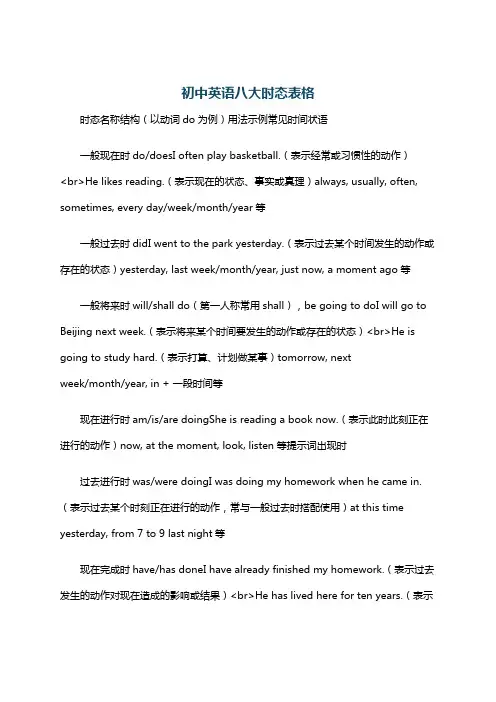
初中英语八大时态表格时态名称结构(以动词do为例)用法示例常见时间状语一般现在时do/doesI often play basketball.(表示经常或习惯性的动作)<br>He likes reading.(表示现在的状态、事实或真理)always, usually, often, sometimes, every day/week/month/year等一般过去时didI went to the park yesterday.(表示过去某个时间发生的动作或存在的状态)yesterday, last week/month/year, just now, a moment ago等一般将来时will/shall do(第一人称常用shall),be going to doI will go to Beijing next week.(表示将来某个时间要发生的动作或存在的状态)<br>He is going to study hard.(表示打算、计划做某事)tomorrow, nextweek/month/year, in + 一段时间等现在进行时am/is/are doingShe is reading a book now.(表示此时此刻正在进行的动作)now, at the moment, look, listen等提示词出现时过去进行时was/were doingI was doing my homework when he came in.(表示过去某个时刻正在进行的动作,常与一般过去时搭配使用)at this time yesterday, from 7 to 9 last night等现在完成时have/has doneI have already finished my homework.(表示过去发生的动作对现在造成的影响或结果)<br>He has lived here for ten years.(表示过去已经开始,持续到现在的动作或状态)already, yet, just, ever, never, for + 时间段, since + 时间点等过去完成时had doneWhen I got to the station, the train had already left.(表示在过去某个时间或动作之前已经发生或完成的动作,即“过去的过去”)by the end of last year, before + 一般过去时的句子等将来进行时will be doingI will be having a meeting at this time tomorrow.(表示将来某个时刻或时间段正在进行的动作)at this time tomorrow等。
小升初英语必会八大时态最全总结表格
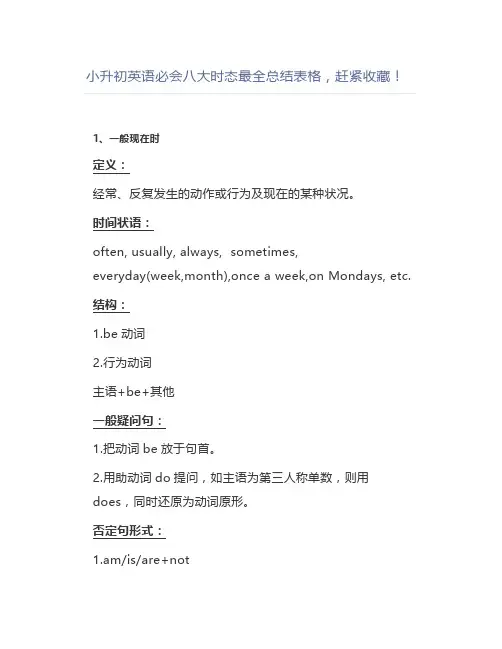
小升初英语必会八大时态最全总结表格,赶紧收藏!1、一般现在时定义:经常、反复发生的动作或行为及现在的某种状况。
时间状语:often, usually, always, sometimes,everyday(week,month),once a week,on Mondays, etc. 结构:1.be动词2.行为动词主语+be+其他一般疑问句:1.把动词be放于句首。
2.用助动词do提问,如主语为第三人称单数,则用does,同时还原为动词原形。
否定句形式:1.am/is/are+not2.此时态的谓语动词若为行为动词,则在其前加don’t;若主语为第三人称单数,则用doesn’t,同时还原行为动词。
2、现在进行时定义:表示现阶段或说话时正在进行的动作或状态。
时间状语:now, at this time, these days, etc.结构:主语+am/ is/ are +doing一般疑问句:把be动词放在句首。
否定句形式:主语+am/ is/ are +not +doing3、一般过去时定义:过去某个时间里发生的动作或状态;过去习惯性、经常性的动作、行为。
时间状语:ago, yesterday, last week(month, year…), in 2000, just now, one day, long long ago, etc.结构:1.was/were2.行为动词过去式一般疑问句:1.把was或 were放于句首。
2.用助动词did提问,同时还原为动词原形。
否定句形式:1.主语+was/were+ not2.在行为动词前加do在其前加didn’t,同时还原行为动词。
4、过去进行时定义:表示过去某段时间或某一时刻正在发生或进行的动作或行为。
时间状语:at this time yesterday或以when引导的谓语动词是一般过去时的时间状语等。
结构:主语+was/were+ doing一般疑问句:把was或were放在句首。
初中英语八种时态归纳总结表格版
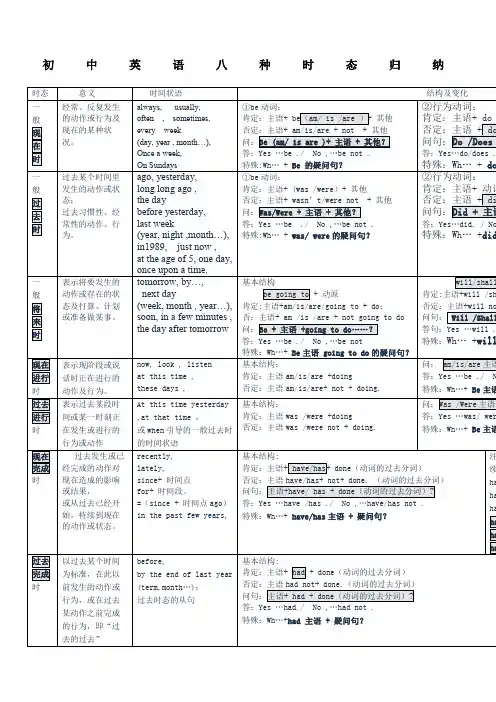
结构及变化
②行为动词: 肯定:主语+ do( 否定:主语 + do 问句:Do /Does
答:Yes…do/does .
特殊:Wh… + do ②行为动词: 肯定:主语+ 动词 否定:主语 + di 问句:Did + 主语
答:Yes…did. / No
特殊:Wh… +did
will/shall 肯定:主语+will /sh 否定:主语+will no 问句: Will /Shall 答句:Yes …will .
now, look , listen at this time , these days ,
①be 动词: 肯定:主语+ be(am/ is /are )+ 其他 否定:主语+ am/is/are + not + 其他 问:Be (am/ is are )+ 主语 + 其他? 答:Yes …be ./ No ,…be not . 特殊:Wh… + Be 的疑问句? ①be 动词: 肯定:主语+ (was /were)+ 其他 否定:主语+ wasn’t/were not + 其他 问:Was/Were + 主语 + 其他? 答:Yes …be ./ No ,…be not . 特殊:Wh… + was/ were 的疑问句?
基本结构 be going to + 动原
肯定:主语+am/is/are/going to + do; 否:主语+ am /is /are + not going to do 问:Be + 主语 +going to do……? 答:Yes …be ./ No ,…be not 特殊:Wh…+ Be 主语 going to do 的疑问句? 基本结构: 肯定:主语 am/is/are +doing 否定:主语 am/is/are+ not + doing.
英语常用八大时态
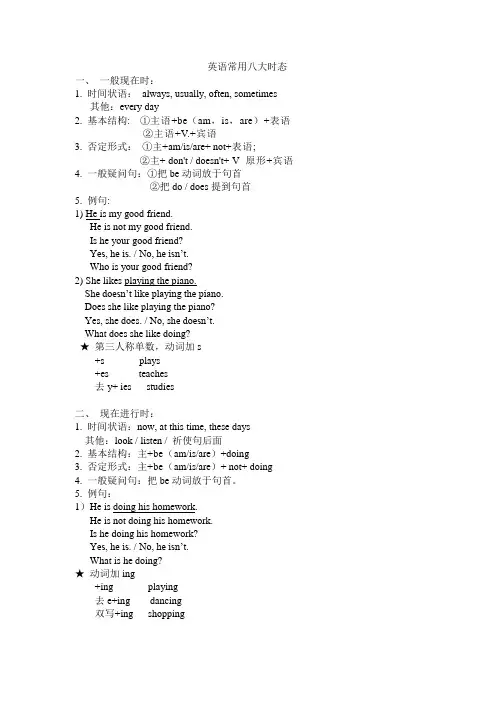
英语常用八大时态一、一般现在时:1. 时间状语:always, usually, often, sometimes其他:every day2. 基本结构: ①主语+be(am,is,are)+表语②主语+V.+宾语3. 否定形式:①主+am/is/are+ not+表语;②主+ don't / doesn't+ V 原形+宾语4. 一般疑问句:①把be动词放于句首②把do / does提到句首5. 例句:1) He is my good friend.He is not my good friend.Is he your good friend?Yes, he is. / No, he isn’t.Who is your good friend?2) She likes playing the piano.She doesn’t like playing the piano.Does she like playing the piano?Yes, she does. / No, s he doesn’t.What does she like doing?★第三人称单数,动词加s+s plays+es teaches去y+ ies studies二、现在进行时:1. 时间状语:now, at this time, these days其他:look / listen / 祈使句后面2. 基本结构:主+be(am/is/are)+doing3. 否定形式:主+be(am/is/are)+ not+ doing4. 一般疑问句:把be动词放于句首。
5. 例句:1)He is doing his homework.He is not doing his homework.Is he doing his homework?Yes, he is. / No, he isn’t.What is he doing?★动词加ing+ing playing去e+ing dancing双写+ing shopping三、一般过去时:1. 时间状语:ago, yesterday, last week, just now,this morning, the day before yesterday,in 1990, in the past2. 基本结构:①主+ be(was were)+表语②主语+V过去式+宾语3. 否定形式:①主+be(was/were)not+表语;②主+did not +V(原形)+表语4. 一般疑问句:① was were放于句首;② did用于句首,动词变回原形。
英语八大时态总结一览表
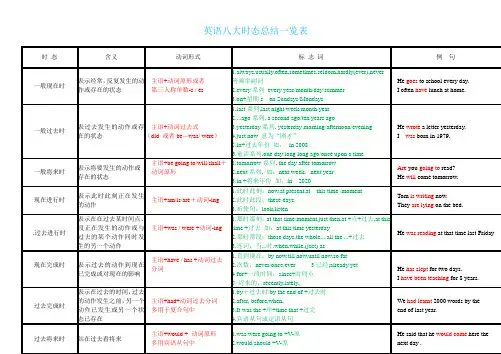
Hegoesto school every day.
Ioftenhavelu
主语+动词过去式
(did或者be—was/ were)
st系列,last night/week/month/year
2....ago系列, a second ago/ten years ago
3.yesterday系列, yesterday morning/afternoon/evening
4.just now意为“刚才”
5.in+过去年份如:in 2008
6.童话系列,one day/long long ago/once upon a time
分词
1.直到现在;by now,till now,until now,so far
2.次数;never/once/ever3已经;already/yet
4for+一段时间;since+时间点
5近来的;recently,lately,
Hehas sleptfor two days.
Ihave been teachingfor 8 years.
3.祈使句;look,listen
Tomis writingnow.
Theyare lyingon the bed.
.过去进行时
表示在在过去某时间点、段正在发生的动作或与过去的某个动作同时发生的另一个动作
主语+was / were +动词-ing
1.那时那刻;at that time/moment,just then,at+点+过去,at this time +过去如:at this time yesterday
八个时态总汇表格,完整版

7
现在完成时
主语+have/has+not+V过分+其他.
have/has+V过分
have/has+主语+V过分+其他? have/has+主语+been+V-ing +其他? had+主语+V过分+其他?
8 9
现在完成进行时 主语+have/has+not+been+V过分+其他. 过去完成时 主语+had+not+V过分+其他.
序号 1
名称 一般现在时
否定式
初中生学习八大时态总汇 结
构
疑
问
式
1.主语+be+not+其他. 2.主语+do/does+not+V原形+其他.
1.be动词包括is am are 2.V+s/es
1.beቤተ መጻሕፍቲ ባይዱ主语+其他? 2.do/does+主语+V原形+其 他?
2
一般过去时
主语+did+not+V原形+其他.
Yes,主语+have/has.
No,主语+have/has+not.
Yes,主语+have/has. Yes,主语+had.
No,主语+have/has+not. No,主语+had+not.
Yes,主语+did.
No,主语+did+not
Yes,主语+be.
英语八大时态综合总结表格
主语+ would/should +动词原形
He said he would help me with my project.
以上是对英语八大时态的综合总结表格,通过对每种时态的结构和示例进行总结,希望能够帮助您更好地理解和运用英语时态。
英语八大时态综合总结表格
下面是英语八大时态的综合总结表格:
时态
结构
示例
现在简单时态
主语+动词原形
I eat an apple.
现在进行时态
主语+ be动词+现在分词
She is studying at the library.
现在完成时态
主语+ have/has +过去分词
They have already finished their homework.
将来简单时态
主语+ will/shall +动词原形
They will arrive at 8 o'c#43; will/shall + be +现在分词
We will be watching a movie at the cinema tomorrow evening.
过去简单时态
主语+过去式
He played basketball yesterday.
过去进行时态
主语+ was/were +现在分词
I was sleeping when you called me.
过去完成时态
主语+ had +过去分词
We had already left when it started to rain.
英语八大时态总结表
英语八大时态总结表时态是英语语法中非常重要的部分,它决定了句子的时间和态度。
掌握英语的八大时态对于正确理解和运用英语语法至关重要。
下面将对英语的八大时态进行详细总结。
一、一般现在时态(Simple Present Tense)一般现在时用于描述经常或一直存在的情况、习惯性的行为或现在的真理。
它的结构是主语+动词原形。
例如:1. The sun rises in the east.(太阳从东方升起。
)2. I usually go to bed early.(我通常早睡。
)3. They live in New York.(他们住在纽约。
)二、一般过去时态(Simple Past Tense)一般过去时用于描述已经发生并结束了的过去事件或状态。
它的结构是主语+动词过去式。
例如:1. She studied abroad last year.(她去年出国留学了。
)2. They visited their grandparents yesterday.(他们昨天拜访了他们的祖父母。
)3. We lived in London for five years.(我们在伦敦住了五年。
)三、一般将来时态(Simple Future Tense)一般将来时用于描述将来会发生的事件或状态。
它的结构是主语+will+动词原形。
例如:1. I will meet my friends tomorrow.(我明天会见我的朋友。
)2. They will travel to Japan next month.(他们下个月会去日本旅行。
)3. She will study hard for her exams.(她将为考试努力学习。
)四、现在进行时态(Present Continuous Tense)现在进行时用于描述正在进行的动作或当前的情况。
它的结构是主语+am/is/are+动词-ing形式。
例如:1. She is watching TV at the moment.(她此刻正在看电视。
英语八大时态总结表 8种基本时态结构句型
英语八大时态总结表 8种基本时态结构句型英语八大时态总结表8种基本时态结构句型英语八大时态分别是:一般现在时、一般过去时、现在进行时、过去进行时、现在完成时、过去完成时、一般将来时和过去将来时。
通常现在时:经常、反反复复出现的动作或犯罪行为及现在的某种状况。
时间状语:always,usually,often,sometimes,everyweek(day,year,month…),onceaweek,onsundays,etc.基本结构:①be动词;②犯罪行为动词否定形式:①am/is/are+not;②此时态的谓语动词若为行为动词,则在其前加don't,如主语为第三人称单数,则用doesn't,同时还原行为动词。
通常疑问句:①把be动词摆于句首;②用助动词do回答,例如主语为第三人称单数,则用does,同时,还原成犯罪行为动词。
一般过去时:过去某个时间里发生的动作或状态;过去习惯性、经常性的动作、行为。
时间状语:ago,yesterday,thedaybeforeyesterday,lastweek(year,night,month…),in1989,justno w,attheageof5,oneday,longlongago,onceuponatime,etc.基本结构:①be动词;②行为动词驳斥形式:①was/were+not;②在犯罪行为动词kadidn't,同时还原成犯罪行为动词。
一般疑问句:①was或were放于句首;②用助动词do的过去式did提问,同时还原行为动词。
现在展开时:则表示现阶段或骂人时正在展开的动作及犯罪行为。
时间状语:now,atthistime,thesedays,etc.基本结构:am/is/are+doing否定形式:am/is/are+not+doing.通常疑问句:把be动词摆于句首。
过去进行时:表示过去某段时间或某一时刻正在发生或进行的行为或动作。
初中英语八大时态总结归纳
初中英语八大时态
一般现在时:am/is/are + 动词原形
一般过去时:was/were + 动词的过去式
现在进行时:am/is/are + 动词的现在分词
过去进行时:was/were + 动词的现在分词
一般将来时:will + 动词原形
过去将来时:助动词would + 动词原形或was/were going to + 动词原形
现在完成时:助动词have/has + 动词的过去分词
过去完成时:助动词had + 动词的过去分词
一般现在时:every day,week,mouth,year,always,usually,often,sometimes,seldom 一般过去时:yesterday,the day,before,yesterday,just,now,ago,last week
现在进行时:now,these days,this week,all the time
过去进行时:at the day,then,this time yesterday,the hole morning
一般将来时:tomorrow,the day after tomorrow,next time,from now on,later (on),soon 过去将来时:the next day,the following week,soon,one day,in a week
现在完成时:already,yet,never,so far,since,before。
- 1、下载文档前请自行甄别文档内容的完整性,平台不提供额外的编辑、内容补充、找答案等附加服务。
- 2、"仅部分预览"的文档,不可在线预览部分如存在完整性等问题,可反馈申请退款(可完整预览的文档不适用该条件!)。
- 3、如文档侵犯您的权益,请联系客服反馈,我们会尽快为您处理(人工客服工作时间:9:00-18:30)。
英语八大时态总结表
英语八大时态是一般现在时、一般将来时、过去将来时、一般过去时、现在完成时、过去完成时、过去进行时、现在进行时。
一、一般现在时
概念:经常、反复发生的动作或行为及现在的某种状况。
时间状语:always, usually, often, sometimes, every week (day, year, month…), once a week, on Sundays, etc.
基本结构:①be动词;②行为动词
否定形式:①am/is/are+not; ②此时态的谓语动词若为行为动词,则在其前加don't,如主语为第三人称单数,则用doesn't,同时还原行为动词。
一般疑问句:①把be动词放于句首;②用助动词do提问,如主语为第三人称单数,则用does,同时,还原行为动词。
二、一般过去时
概念:过去某个时间里发生的动作或状态;过去习惯性、经常性的动作、行为。
时间状语:ago, yesterday, the day before yesterday, last week(year, night, month…), in 1989, just now, at the age of 5, one day, long long ago, once upon a time, etc.
基本结构:①be动词;②行为动词
否定形式:①was/were+not;②在行为动词前加didn't,同时还原行为动词。
一般疑问句:①was或were放于句首;②用助动词do的过去式did提问,同时还原行为动词。
三、现在进行时
概念:表示现阶段或说话时正在进行的动作及行为。
时间状语:now, at this time, these days, etc.
基本结构:am/is/are+doing
否定形式:am/is/are+not+doing.
一般疑问句:把be动词放于句首。
四、过去进行时
概念:表示过去某段时间或某一时刻正在发生或进行的行为或动作。
时间状语:at this time yesterday, at that time或以when引导的谓语动词是一般过去时的时间状语等。
基本结构:was/were+doing
否定形式:was/were + not + doing.
一般疑问句:把was或were放于句首。
五、现在完成时
概念:过去发生或已经完成的动作对现在造成的影响或结果,或从过去已经开始,持续到现在的动作或状态。
时间状语:recently, lately, since…for…,in the past few years, etc.
基本结构:have/has + done
否定形式:have/has + not +d one.
一般疑问句:have或has。
六、过去完成时
概念:以过去某个时间为标准,在此以前发生的动作或行为,或在过去某动作之前完成的行为,即“过去的过去”
时间状语:before,by,the end of last year(term,month)......
基本结构:had done
否定:had not done
一般疑问句:had放句首
七、一般将来时
概念:表示将要发生的动作,或存在的状态及打算,计划或准备做某事
时间状语:tomorrow,next day,soon,in a few minutes....
基本结构:1、be going to 2、will/shall do
否定:1、was / were not 2、行为动词前加didn't ,同时还原行为动词一般疑问句:1、be 放于句首2、will /shall 提于句首
八、过去将来时
概念:立足于过去某一时刻,从过去看将来,常用于宾语从句中
时间状语:the next day,the following month
基本结构:1、be going to do 2、would /should do
否定:1、be not going to 2、would/should not do一般疑问句:be ,would/should 放于句首。
